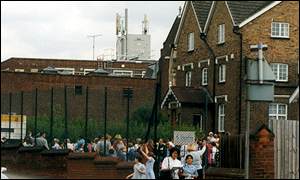| You are in: Education | ||||||||||||||||||||||
|
Monday, 13 August, 2001, 22:16 GMT 23:16 UK
Mobile phone mast 'threatens school'

Parents feel threatened by mast next to school
A primary school could be in trouble next term as parents threaten to take their children elsewhere - after a mobile phone mast was erected next door to the school.
Governors of St Mary's Primary in Hornchurch, Essex, say the BT Cellnet mast was put up suddenly at the end of last term on the roof of the neighbouring engineering works. Because the building is low-level, no planning permission was needed. Now the popular, oversubscribed Roman Catholic school faces the prospect of a mass withdrawal of pupils by worried parents - and the consequent loss of funding. "If it can happen to us, it can happen to anyone," said governor Jo Patten-Walsh, who has a daughter at the school. New network The mast involved is one of the new type for third generation or 3G mobile phones. Last year a government-sponsored scientific inquiry, led by Sir William Stewart, promised tougher rules for transmitter masts as a precaution against potential health risks. The Trade and Industry select committee said in April that urgent steps were needed to introduce some greater "certainty and clarity into the planning regime for telecom masts". But the committee also urged a moratorium on further changes to planning laws in the medium term to allow for the increasing demand for access to mobile phone technology. The government had already altered its regulations strengthening the requirements for public consultation on masts of 15 metres and below - as in the St Mary's case. They also increased time for authorities to deal with applications to 56 days and say school governors must be consulted on all proposals for new masts on or near a school or college. 'Not consulted' But the St Mary's Mast Action Group says this was not done in their case before the mast was installed on 13 July on the roof of Rodwell Engineering. Jo Patten-Walsh said: "The road was closed and when people asked what was going on they were told it was some repair work to Rodwell's roof, to make it safe, so it wasn't until the BT van turned up the following Tuesday that they realised." That was just before the end of term. Many parents had written to the local education authority, saying they would take their children out of the school next term - and had received letters threatening them with legal action, she said. Social responsibility BT says on a section of its website about its "commitment to a better society": "We have also committed not to install base stations on or near schools without seeking the agreement of the governors and the PTA or equivalent." But St Mary's governor Jo Patten-Walsh says neither they nor the head teacher, Michael Coy, knew about the plans. Planning laws allow masts to be put up without special permission where the total installation is less than 15 metres high. A Havering Council spokesperson said: "In this case the applicant is only required to put up a site notice, which they have done in this instance, and to give the council notification of the construction. "The council has limited control over the detailed siting and appearance of mobile phone masts. As this installation was on a building, its siting and appearance was acceptable." Scientific concerns The action group disagrees and wants the mast removed. One of its members is parent and resident Danny McLaughlin - who is a lecturer in neuropathology at Bart's and The London School of Medicine and Dentistry. He has written to BT about his concerns. One of the issues he takes up is BT's statement: "BT has recently audited its compliance with the ICNIRP standards for radio frequency emissions recommended by the Stewart Inquiry and has found that all its sites are well within the guidelines, in most cases by several orders of magnitude." Dr McLaughlin said this was a red herring. "You should know that the concerns of scientists over RF radiation does not revolve around thermal effects produced by high level emissions. "The main worries surround the unknown long-term harm that could result from non-thermal effects on cells and molecules (DNA and proteins) that has yet to be properly studied." Meeting BT Cellnet has now appointed five community liaison officers because of the rise in disputes of this sort. The officer for the area involved, Angela Johnson, said: "It is a crucial mast for service in the area. We have looked at other sites and this is the best possible one." She said the antennae on it were not facing the school so their emissions did not fall on it. She is to meet the leader of the council, the local MP and representatives of the area on 24 August to discuss the situation. "There are more emissions from televisions or phones themselves than from one of these base stations but people let their children sit in front of televisions," she said.
|
See also:
Internet links:
The BBC is not responsible for the content of external internet sites Top Education stories now:
Links to more Education stories are at the foot of the page.
|
||||||||||||||||||||
Links to more Education stories
|
|
|
^^ Back to top News Front Page | World | UK | UK Politics | Business | Sci/Tech | Health | Education | Entertainment | Talking Point | In Depth | AudioVideo ---------------------------------------------------------------------------------- To BBC Sport>> | To BBC Weather>> ---------------------------------------------------------------------------------- © MMIII | News Sources | Privacy |
|